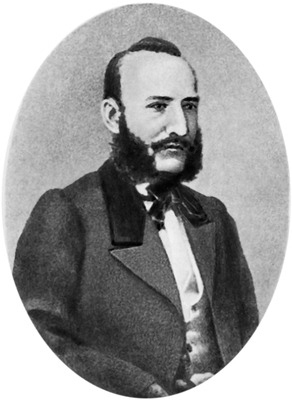<Back to Index>
- Folklorist Alexander Nikolayevich Afanasyev, 1826
- Sculptor Louis - Eugène Simonis, 1810
- Elector of Bavaria Maximilian II Emanuel, 1662
PAGE SPONSOR

Alexander Nikolayevich Afanasyev (Afanasief or Afanasiev, Russian: Алекса́ндр Никола́евич Афана́сьев) (11 July 1826 – 23 October 1871) was a Russian folklorist who recorded and published over 600 Russian folktales and fairytales, by far the largest folktale collection by any one man in the world. His first collection was published in eight volumes from 1855 – 67, earning him the reputation of a Russian counterpart to the Brothers Grimm.
He was educated at a gymnasium in Voronezh and studied law at Univeristy of Moscow, in which he attended the lectures of Konstantin Kavelin and Timofey Granovsky. His burgeoning career as a professor of history was cut short by denunciation of his work on the part of Sergey Uvarov. He then turned his attention to journalism and brought out a series of articles about leading personalities of the literary life of the previous century, including Nikolay Novikov, Denis Fonvizin, and Antiokh Kantemir.
Censured by the authorities for his contacts with Herzen and suffering from tuberculosis, Afanasyev ended his life in penury, forced to sell his library to enable himself to eat. He died in Moscow aged 45. Afanasyev
collected many Russian folk tales throughout the course of his career.
He is said to have become acquainted with folktales from local women in
his home town of Bobrov.
He genuinely hoped that the revival of the native Russian fairy tales
would promote the triumph of the Russian language over the French language, which had been adopted by the Russian aristocracy. It was in the 1850s that Afanasiev found his vocation in folklore studies. His first scholarly articles - The Wizards and Witches, Sorcery in the Ancient Rus, Pagan Legends about the Buyan Island -
drew heavily upon the so-called Mythological school that treated
folklore as a mine of information for the study of more ancient pagan
mythology. His definitive work on the subject - The Poetic Outlook on Nature by the Slavs - was published in three volumes between 1865 and 1869. In such an interpretation, he regarded the fairy tale Vasilissa the Beautiful as depicting the conflict between the sunlight (Vasilissa), the storm (her stepmother), and dark clouds (her stepsisters). In the course of his studies of the Russian folklore Afanasyev amassed a collection of more than 600 Russian folktales - some of them contributed by Vladimir Dahl, others taken from the archives of the Russian Geographical Society and
grouped by Afanasiev according to their themes, imagery, and style. He
owes his prominent place in the history of Slavonic philology chiefly to Narodnye russkie skazki (Russian Fairy Tales), eight volumes modelled on the famous collection of the Brothers Grimm and published between 1855 and 1863. Afanasyev edited several other compilations which included: Russian Fairy Tales for Children comprising a set of animal, magic and humorous tales from his collection that were suitable to children; Russian Folk Legends which was banned due to the harsh censorship in Tsarist Russia (the church thought the collection was blasphemous); and Russian Forbidden Tales, an assortment of unprintable tales from Russia that had to be published in Switzerland anonymously. Their obscene and anticlerical subject matter made their publication in Imperial Russia unthinkable.
Prior
to Afanasyev's works in the 1850s, only a few attempts had ever been
made to record or study the folk beliefs of peasant Russia. Though a
written Russian language
(Church Slavonic)
had existed since the 10th century, it was used almost solely by the
church and only for parochial written works. It was not until the 18th
and 19th centuries that a sizable body of secular literature developed
in the vernacular Russian. Thus, Afanasyev's collections made a highly
valuable contribution to the dissemination and legitimization of
Russian culture and folk belief. The influence of these folk tales can
be seen in the works of many writers and composers, notably Rimsky - Korsakov (Sadko, The Snow Maiden) and Stravinsky (The Firebird, Petrushka, and L'Histoire du Soldat).